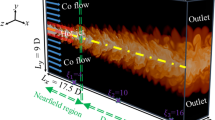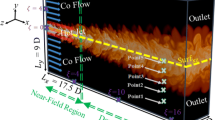Abstract
The present manuscript reports results of numerical simulations of turbulent lifted jet flames of methane with special emphasis placed on the autoignition effects. The impact of dilution with burned gases on the flame stabilization is analyzed under the conditions of a laboratory jet flame surrounded by a vitiated air coflow. In this geometry, mass flow rates, temperature levels and exact chemical composition of hot products mixed with air are fully determined. The effects of both finite rate chemistry and partially premixed combustion are taken into account within a Lagrangian intermittent framework. Detailed chemistry effects are incorporated through the use of chemical time scales, which are tabulated as functions of the mixture fraction. The concept of residence time (or particle age) and the transport equation for the mean scalar dissipation rate of the mixture fraction fluctuations, i.e., \(\widetilde{\varepsilon}_Z=\overline{\rho \mathcal{D} (\partial Z'' / \partial x_i) (\partial Z'' / \partial x_i) }/\overline{\rho}\), are also considered. This allows to improve the description of turbulent mixing including both the large scales engulfment processes through the consideration of the residence time scale, as well as the small scales molecular mixing processes the intensity of which is set by the integral scalar (mixing) time scale \(\tau_Z=\widetilde{Z''^2}/\widetilde{\varepsilon}_Z\). Numerical simulations of the turbulent diluted jet flame of methane studied by Cabra and his co-workers are performed. The flame liftoff height is reasonably well-captured and the computational results display a fairly satisfactory level of agreement with experimental data. They also confirm that the consideration of an additional transport equation for the mean scalar dissipation rate may significantly improve the computational results. The investigation is supplemented by a sensitivity analysis of the scalar to turbulence time scale ratio C mix = τ Z /τ t often referred to as the mixing constant. Finally, the manuscript ends with the application of the proposed closure to experimental conditions which are characterized by variations of (i) the jet exit velocity, (ii) coflow velocity and (ii) coflow temperature.
Similar content being viewed by others
References
Villermaux, J., Devillon, J.C.: Représentation de la coalescence et de la redispersion des domaines de ségrégation dans un fluide par un modèle d’interaction phénoménologique. In: Proceedings of the 2nd International Symposium on Chemical Reaction Engineering, Amsterdam, vol. B, pp. 1–13. Elsevier, Amsterdam (1972)
Borghi, R., Gonzalez, M.: Applications of Lagrangian models to turbulent combustion. Combust. Flame 63, 239–250 (1986)
Dopazo, C., O’Brien, E.E.: A probabilistic approach to autoignition of a turbulent mixture. Acta Astronautica 1, 12–39 (1974)
Sandberg, M., Sjöjberg, M.: The use of moments for assessing air quality in ventilated rooms. Build. Environ. 18, 181–197 (1983)
Mura, A., Demoulin, F.X.: Lagrangian intermittent modelling of turbulent lifted flames. Combust. Theory Model. 11, 227–257 (2007)
Spalding, D.B.: A note on mean residence-times in steady flows of arbitrary complexity. Chem. Eng. Sci. 9, 74–77 (1958)
Cabra, R., Myhrvold, T., Chen, J.Y., Dibble, R.W.: Simultaneous laser Raman-Rayleigh-LIF measurements and numerical modeling results of a lifted turbulent H 2/N 2 jet flame in a vitiated co-flow. Proc. Combust. Inst. 29, 1881–1888 (2002)
Cabra, R., Chen, J.Y., Dibble, R.W., Karpetis, A.N., Barlow, R.S.: Lifted methane air jet flames in a vitiated co-flow. Combust. Flame 143, 491–506 (2005)
Gordon, R.L., Masri, A.R., Mastorakos, E.: Simultaneous Rayleigh temperature, OH − and CH2O − LIF imaging of methane jets in a vitiated co-flow. Combust. Flame 155, 181–195 (2008)
Masri, A.R., Cao, R.R., Pope, S.B., Goldin, G.M.: PDF calculations of turbulent lifted flames of H2/N2 fuel issuing into a vitiated co-flow. Combust. Theory Model. 8, 1–22 (2003)
Pope, S.B.: Computationally efficient implementation of combustion chemistry using in situ adaptive tabulation. Combust. Theory Model. 1, 44–63 (1997)
Cao, R.R., Pope, S.B., Masri, A.R.: Turbulent lifted flames in a vitiated coflow investigated using joint PDF calculations. Combust. Flame. 142, 438–453 (2005)
Gordon, R.L., Masri, A.R., Pope, S.B., Goldin G.M.: Transport budgets in turbulent lifted flames of methane autoigniting in a vitiated co-flow. Combust. Flame 151, 495–511 (2007)
Gordon, R.L., Masri, A.R., Pope, S.B., Goldin G.M.: A numerical study of auto-ignition in turbulent lifted flames issuing into a vitiated co-flow. Combust. Theory Model. 11, 351–376 (2007)
Domingo, P., Vervisch, L., Veynante, D.: Large-eddy simulation of a lifted methane jet flame in a vitiated coflow. Combust. Flame 152, 415–432 (2008)
Patwardhan, S.S., De, S., Lakshmisha, K.N., Raghunandan, B.N.: CMC simulations of lifted turbulent jet flame in a vitiated coflow. Proc. Combust. Inst. 32, 1705–1712 (2009)
Michel, J.B., Colin, O., Angelberger, C., Veynante, D.: Using the tabulated diffusion flamelet model ADF-PCM to simulate a lifted methane air jet flame. Combust. Flame 156, 1318–1331 (2009)
Ihme, M., See, Y.C.: Prediction of autoignition in a lifted methane/air flame using an unsteady flamelet/progress variable model. Combust. Flame 157, 1850–1862 (2010)
Borghi, R., Pourbaix, E.: On the coupling of complex chemistry with a turbulent combustion model. Physico-Chemical Hydrodynamics 2, 65–71 (1981)
Obounou, M., Gonzalez, M., Borghi, R.: A Lagrangian model for predicting turbulent diffusion flames with chemical kinetic effects. Proc. Combust. Inst. 25, 1107–1113 (1994)
Fallot, L., Gonzalez, M., Elamraoui, R., Obounou, M.: Modelling finite-rate chemistry effects in nonpremixed turbulent combustion: test on the bluff-body stabilized flame. Combust. Flame 110, 298–314 (1997)
Demoulin, F.X., Borghi, R.: PDF modelling of turbulent spray combustion. Combust. Sci. Technol. 158, 249–271 (2000)
Demoulin, F.X., Borghi, R.: Modelling turbulent spray combustion with application to diesel like experiment. Combust. Flame 129, 281–293 (2002)
Mura, A., Izard, J.F.: Numerical simulation of supersonic non premixed turbulent combustion in a Scramjet combustor model. J. Propul. Power 26, 858–868 (2010)
Mouangue, R., Obounou, M.: Numerical simulation of turbulent diffusion flames of H 2/Air. Phys. Chem. News 50, 69–78 (2009)
Cabra, R., Chen, J.Y., Dibble, R.W., Karpetis, A.N., Barlow, R.S.: Lifted H2/N2 jet flame in a vitiated coflow. http://www.me.berkeley.edu/cal/vcb/data/VCHNData.html. Accessed 21 Sept 2013
Cabra, R.: Turbulent jet flames into a vitiated coflow. Technical Report, University of California, Berkeley (2004)
Gordon, R.L., Starner, S.H., Masri, A.R., Bilger, R.W.: Further characterisation of lifted hydrogen and methane flames issuing into a vitiated coflow. In: Proceedings of the 5th Asia-Pacific Conference on Combustion, pp. 333–336. University of Adelaïde (2005)
Izard, J.F., Lehnasch, G., Mura, A.: A Lagrangian model of combustion in high speed flows: application to scramjet conditions. Combust. Sci. Technol. 181, 1372–1396 (2009)
Pope, S.B.: The relationship between the probability approach and particle models for reaction in homogeneous turbulence. Combust. Flame 35, 41–45 (1979)
Borghi, R.: Turbulent combustion modelling. Prog. Energy Combust. Sci. 14, 245–292 (1988)
Cant, R.S., Mastorakos, E.: Flow with non premixed reactants. In: An Introduction to Turbulent Reacting Flows, pp. 63–86. Imperial College Press, World Scientific Publishing Co. Pte. td., London, UK (2008)
Launder, B.E.: Heat and mass transport. In: Bradshaw, P. (ed.) Turbulence. Topics in Applied Physics, pp. 231–287. Springer-Verlag, Berlin, Heidelberg (1976)
Sanders, J.P., Gökalp, I.: Scalar dissipation rate modelling in variable density turbulent axisymmetric jets and diffusion flames. Phys. Fluids 10, 938–948 (1998)
Mantel, T., Borghi, R.: A new model of premixed wrinkled flame propagation based on a scalar dissipation equation. Combust. Flame 96, 443–457 (1994)
Gomet, L., Robin, V., Mura, A.: Influence of residence and scalar mixing time scales in non premixed combustion in supersonic turbulent flows. Combust. Sci. Technol. 84, 1471–1501 (2012)
Mura, A., Borghi, R.: Towards an extended scalar dissipation equation for turbulent premixed combustion. Combust. Flame 133, 193–196 (2003)
Apel, W.: Mathématiques Pour La Physique. H & K Editions. http://www.H-K.fr
Lutz, A.E., Kee, R.J., Miller, J.A.: SENKIN: a fortran program for predicting homogeneous gas phase chemical kinetics with sensitivity analysis. SANDIA Report, SAND87-8248, UC-4 (1988)
Kee, R.J., Rupley, F.M., Miller, J.A.: Chemkin-II, a fortran chemical kinetics package for the analysis of gas-phase chemical kinetics. SANDIA Report, SAN89-8009, UC-401 (1989)
Bowman, C.T., Hanson, R.K., Gardiner, W.C., Lissianski, V., Frenklach, M., Goldenberg, M., Smith, G.P., Crosley, D.R., Golden, D.M.: An optimized detailed chemical reaction mechanism for methane combustion and NO formation and reburning. Technical Report Gas Research Institute, Chicago IL, Report No. GRI-97/0020 (1997)
Mastorakos, E.: Ignition of turbulent non-premixed flames. Prog. Energy Combust. Sci. 35, 57–97 (2009)
Chen, J.Y.: Stochastic modeling of partially stirred reactors. Combust. Sci. Technol. 122, 63–94 (1997)
Strozzi, C., Sotton, J., Mura, A., Bellenoue, M.: Experimental and numerical study of the influence of temperature heterogeneities on self-ignition process of methane-air mixtures in a rapid compression machine. Combust. Sci. Technol. 180, 1829–1857 (2008)
Demoulin, F.X.: Contribution à la modélisation de la combustion turbulente des milieux à deux phases. Ph.D. Thesis, Université de Provence (1999)
Bilger, R.W.: Marker fields for turbulent premixed combustion. Combust. Flame 138, 188–194 (2004)
Enjalbert, N., Domingo, P., Vervisch, L.: Mixing time-history effects in Large Eddy Simulation of non-premixed turbulent flames: flow-controlled chemistry tabulation. Combust. Flame 159, 336–352 (2012)
Ghirelli, F., Leckner, B.: Transport equation for the local residence time of a fluid. Chem. Eng. Sci. 59, 513–523 (2004)
Sandberg, M.: What is ventilation efficiency? Build. Environ. 16, 123–135 (1981)
FLUENT 6.3.26: User manual
FLUENT 6.3.26: UDF manual
Béguier, C., Deskeyser, L., Launder, B.E.: Ratio of scalar and velocity dissipation time scales in shear flow turbulence. Phys. Fluids A 21, 307–310 (1986)
Mura, A., Borghi, R.: Introducing a new partial PDF approach for turbulent combustion modelling. Combust. Flame 136, 377–382 (2004)
Abramovitz, M., Stegun, I.: Gamma function and related functions. In: Handbook of Mathematical Functions. National Bureau of Standards. Applied Mathematics Series 55, Sixth printing, pp. 255–293 (1967)
Press, W.H., Flannery, B.P., Teukolsky, S.A., Vetterling, W.T.: Numerical Recipes in Fortran77 the Art of Scientific Computing. Cambridge University Press (1992)
Lentz, W.J.: Generating Bessel functions in Mie scattering calculations using continued fractions. Appl. Opt. 15, 668–671 (1976)
Author information
Authors and Affiliations
Corresponding author
Rights and permissions
About this article
Cite this article
Mouangue, R., Obounou, M., Gomet, L. et al. Lagrangian Intermittent Modelling of a Turbulent Lifted Methane-Air Jet Flame Stabilized in a Vitiated Air Coflow. Flow Turbulence Combust 92, 731–765 (2014). https://doi.org/10.1007/s10494-013-9512-6
Received:
Accepted:
Published:
Issue Date:
DOI: https://doi.org/10.1007/s10494-013-9512-6




